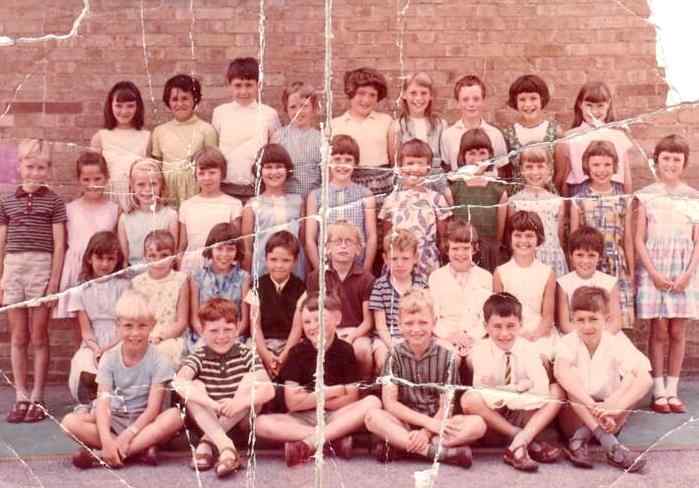
English Primary Schools: School Uniform Chronology

Figure 1.--This English primary school did not require a uniform. There was no national uniform. The choice of whether or not to have a uniform was up to the individual school. Here we see a school, probably in the late 1960s, that decided not to require the children to wear uniforms. A reader writes, "When looking at these children, I find they are still children, full of joy to learn in group. How far from today's who seemed more like little adults."
|
|
We have begun to acquire some information on chronological trends in English school uniforms by decade. We do not have many images of early English primary schools. English state primary schools before World War II did not require uniforms. Many boys wore school caps ans short pants suits, but there was no prescribed uniforms. English primary schools generally did not have uniforms until recently. Many of the new primary schools began instituting simple uniforms in the 1950s and they became more common in the 1960s. Quite a number of schools in the 1970s and 80s had simple uniforms. They were much less elaborate than the state primary schools. Some schools did have blazers, usually the Anglican schools. Many schools required the girkls to wear dresses and the boys short pants. Many schools in the 1990s began adopting seasonal uniforms.
The 1900s
We do not have many images of early English primary schools. English state primary schools before World War II did not require uniforms. Many boys wore school caps ans short pants suits, but there was no prescribed uniforms.
The 1940s
England adopted a major educational reform in the 1940s during World war II. The costs of financing the reform, however, meant that for years after the War it was not possible to implement the reforms. The new primary schools ran only to age 11. Children took the 11+ exam to determine what kind of secondary school they would sattend. Few primasry schools had uniforms.
English primary schools generally did not have uniforms until recently. Girls normally wore dresses. The boys wore a variety of shorts. Knee-length shorts were still quite common. Many of the new primary schools began instituting simple uniforms in the 1950s. This became more and more coimmon as the decade progressed. The uniforms adopted were normally basic. Simple jumpers or dresses were common for the girls. The boys wore seeaters, collared shirts, and grey shorts. Many schools required ties. Sandals were very common.
The educational reforms were fully in place by the 1960s. This meant there were primary schools that ran only to 11 years of age. Schoolwear was much more informal than before the War. Many schools let the children wear casual clothes. This was quite prevalent by the end of the decade. While uniforms were almost universal at the secondary level, this was not the case at the primary level. Quite a number of schools adopted basic uniforms. We are not sure as to the relative distribution of the uniform and non uniform schools. Both options were common. Girls wore jumpers or dresses. The boys commpnly wore sweaters, grey or whire collar shirts, grey short pants and grey kneesocks. The shorts became noticeably shorter as the decade progressed. Sandals were common. Many schools required ties.
The 1970s
Quite a number of schools in the 1970s and 80s had simple uniforms. They were much less elaborate than the state primary schools. Some schools did have blazers, usually the Anglican schools. Most boys wore short pants to primary schools in the 1960s. By the 1970s many of the older boys began wearing long pants. Some schools having uniforms required the boys to wear shorts. Each school had its own unifom regulsations or dress code.
The 1990s
Many schools required the girkls to wear dresses and the boys short pants. Many schools in the 1990s began adopting seasonal uniforms.
HBC-SU

Related Chronolgy Pages in the Boys' Historical Web Site
[The 1880s]
[The 1930s]
[The 1940s]
[The 1950s]
[The 1960s]
[The 1970s]
[The 1980s]
Related Style Pages in the Boys' Historical Web Site
[Long pants suits]
[Short pants suits]
[Socks]
[Eton suits]
[Jacket and trousers]
[Blazer]
[School sandals]
Navigate the Boys' Historical Clothing School Uniform Pages
[Main English Primary School Uniform Page]
[Australia]
[England]
[France]
[Germany]
[Italy]
[Japan]
[New Zealand]
[Scotland]
[United States]
Navigate the Boys' Historical Clothing Web Page
[Introduction]
[Activities]
[Biographies]
[Chronology]
[Clothing styles]
[Countries]
[Girls]
[Bibliographies]
[Contributions]
[FAQs]
[Glossary]
[Satellite sites]
[Tools]
[Boys' Clothing Home]
Created: 11:16 PM 11/29/2004
Last updated: 5:31 AM 12/3/2004




